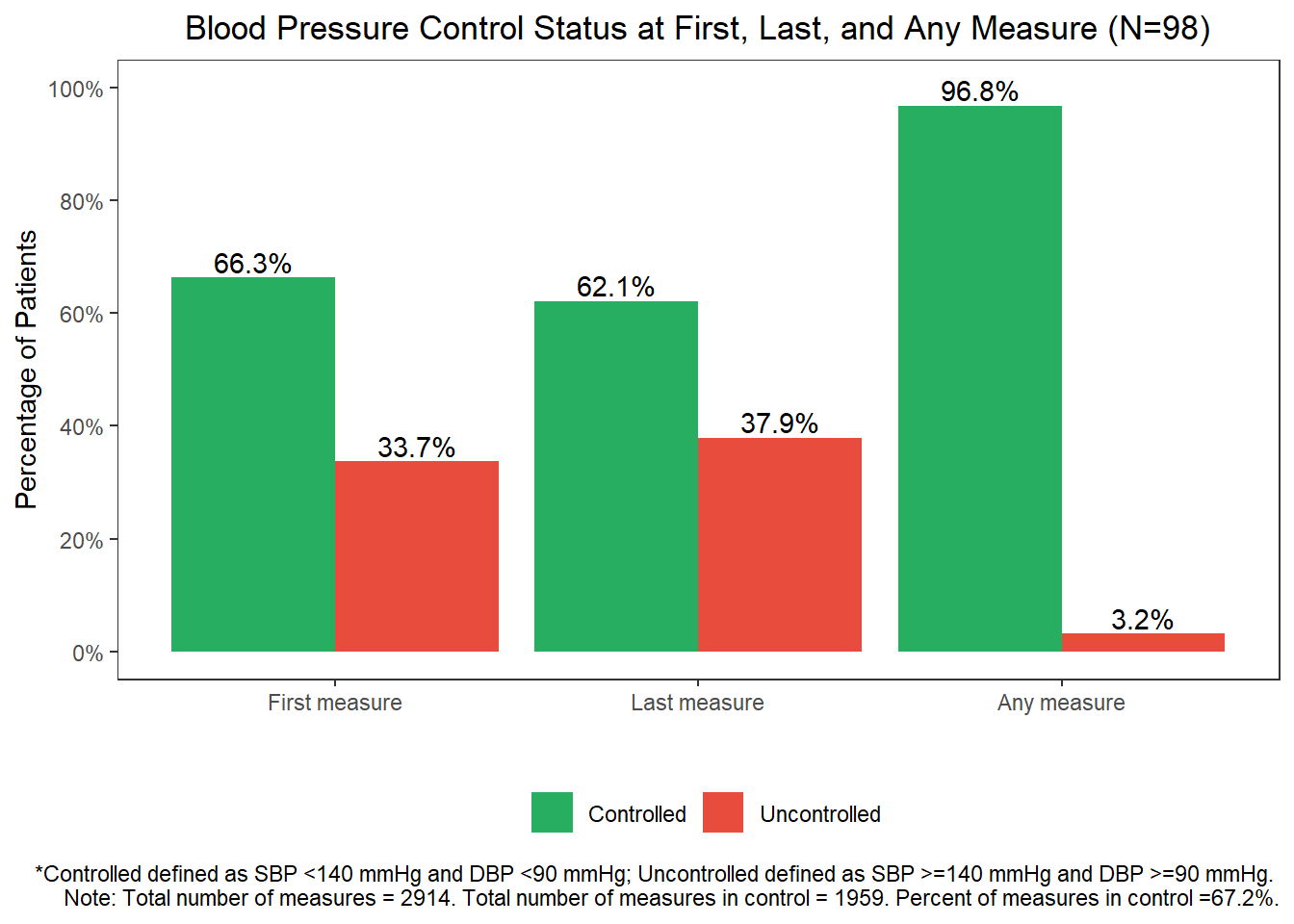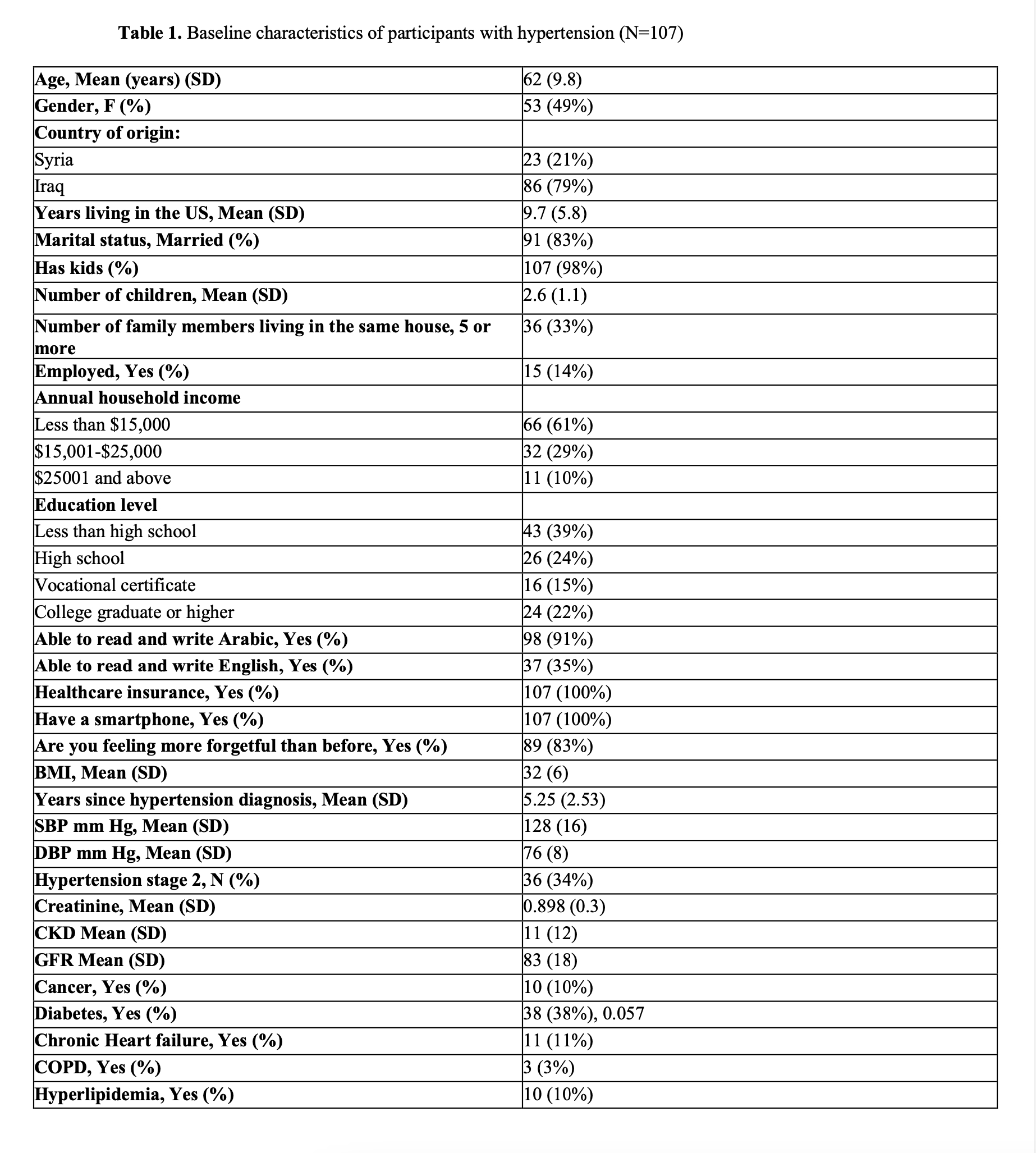Final ID: P2060
A pilot study of an intervention for self-management of blood pressure among refugees fleeing war and resettled in the United States
Abstract Body: Introduction: Blood Pressure (BP) self-monitoring and medication self-titration can effectively mitigate disparities in hypertension control across populations. Refugees have a higher risk of uncontrolled hypertension, cardiovascular diseases (CVD) and other CVD risk factors. BP self-monitoring and medication self-titration have not been tested in refugees.
Methods: We conducted a pilot intervention to assess the feasibility and preliminary efficacy of BP self-management through remote self-monitoring and hypothetical medication self-titration among Middle Eastern and North African (MENA) refugees in San Diego, California. Participants measured their BP at home three times per day, three days per week for four weeks. Data were collected via electronic surveys and electronic health records at baseline and after 4 weeks. We performed Chi-square tests and used Atlas.ti for qualitative thematic analyses.
Results: Of 107 enrollees, 23 Syrians and 86 Iraqis, 53 (49%) were female. The mean age was 62 years (SD=9.8), and 66 (61%) had an annual household income of <$15,000. The average stay in the US was 9.7 years (SD=5.8), and 37 (35%) were able to read and write in English. The pilot intervention was successfully completed by 102 enrollees. At baseline, mean systolic blood pressure SBP was 128 mmHg (SD=16) and 36 individuals (34%) had uncontrolled BP (i.e., SBP ≥ 140 mm Hg). During the intervention, 91% of participants utilized the BP monitor >1 time/week, with week 1 having the highest utilization rate (97%) and week 4 having the lowest utilization rate (84%). For the index capturing intervention usability, functionality, and acceptability, participants scores averaged 80.7 (SD=15.8) showing a significant intervention preference. Lastly, (14%) of participants self-titrated BP medication based on SBP readings during the intervention, and (22%) correctly answered the hypothetical medication-titration question indicating the ability to follow the hypothetical medication-titration protocol. Qualitative analyses indicated a preference for provider-instructed medication titration, family support, and hypertension education to assist self-titration decisions.
Conclusions: A large proportion of MENA refugees live in poverty and have uncontrolled BP. Self-monitoring is feasible, but medication self-titration remains a barrier in MENA refugees residing in San Diego. Results open doors for refugee-focused CVD health education efforts focused on medication self-titration.
Methods: We conducted a pilot intervention to assess the feasibility and preliminary efficacy of BP self-management through remote self-monitoring and hypothetical medication self-titration among Middle Eastern and North African (MENA) refugees in San Diego, California. Participants measured their BP at home three times per day, three days per week for four weeks. Data were collected via electronic surveys and electronic health records at baseline and after 4 weeks. We performed Chi-square tests and used Atlas.ti for qualitative thematic analyses.
Results: Of 107 enrollees, 23 Syrians and 86 Iraqis, 53 (49%) were female. The mean age was 62 years (SD=9.8), and 66 (61%) had an annual household income of <$15,000. The average stay in the US was 9.7 years (SD=5.8), and 37 (35%) were able to read and write in English. The pilot intervention was successfully completed by 102 enrollees. At baseline, mean systolic blood pressure SBP was 128 mmHg (SD=16) and 36 individuals (34%) had uncontrolled BP (i.e., SBP ≥ 140 mm Hg). During the intervention, 91% of participants utilized the BP monitor >1 time/week, with week 1 having the highest utilization rate (97%) and week 4 having the lowest utilization rate (84%). For the index capturing intervention usability, functionality, and acceptability, participants scores averaged 80.7 (SD=15.8) showing a significant intervention preference. Lastly, (14%) of participants self-titrated BP medication based on SBP readings during the intervention, and (22%) correctly answered the hypothetical medication-titration question indicating the ability to follow the hypothetical medication-titration protocol. Qualitative analyses indicated a preference for provider-instructed medication titration, family support, and hypertension education to assist self-titration decisions.
Conclusions: A large proportion of MENA refugees live in poverty and have uncontrolled BP. Self-monitoring is feasible, but medication self-titration remains a barrier in MENA refugees residing in San Diego. Results open doors for refugee-focused CVD health education efforts focused on medication self-titration.
More abstracts on this topic:
Cognitive Impairment Impedes the Acquisition of Self-Care Management Skills in Patients with Heart Failure
Irie Daisuke, Kurimoto Ritsuko, Matoba Satoaki
An Effective mHealth Intervention to Close the Guideline-to-Practice Gap in Hypertension Treatment: mGlide RCTLakshminarayan Kamakshi, Murray Thomas, Mccarthy Teresa, Luepker Russell, Drawz Paul, Streib Christopher, Everson-rose Susan, Connett John, Westberg Sarah


